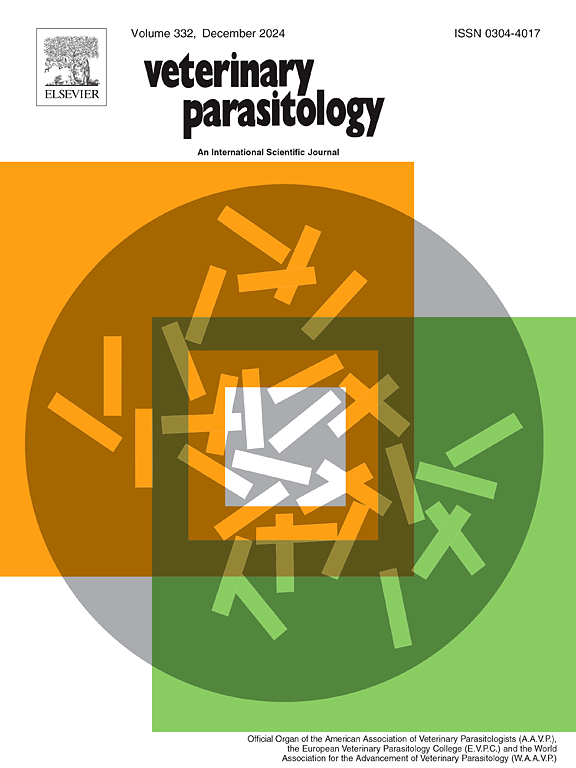瓜蒌果实水乙醇提取物对自然感染胃肠线虫的绵羊的体内抗蠕虫活性。
IF 2
2区 农林科学
Q2 PARASITOLOGY
引用次数: 0
摘要
由胃肠道线虫(GINs)引起的寄生虫感染是造成小型反刍动物(尤其是绵羊)生产损失的主要原因。线虫是热带地区最常见的线虫。由于滥用合成抗蠕虫药来控制蠕虫病,导致产生了抗药性寄生虫。因此,人们对使用植物提取物和天然产品来控制羊的胃肠道线虫越来越感兴趣。因此,本研究旨在评估瓜蒌果实水乙醇提取物对自然感染胃肠线虫的绵羊的体内驱虫活性。首先进行了一项实验,以每公斤体重 2.5 毫克的剂量给药三次,每次间隔 7 天。为此,18 只动物被分为三组:对照组、皮下注射每公斤体重 4.7 毫克的磷酸左旋咪唑治疗组和通过插管口服纯净形式的瓜蒌提取物治疗组。根据该实验的结果,采用相同的实验设计和相同的提取物进行了第二次实验,但提取物的有效性评估是在第 0 天以单剂量 5.0 毫克/千克体重给药。在实验的不同天,对使用提取物处理的组别进行了生化参数测定,并对所有组别进行了线虫种类鉴定。第一次实验的结果表明,与对照组相比,提取物在第 7 天和第 35 天分别减少了 84% 和 83% 的 FEC。这些结果促使我们进行了第二次实验,采用相同的实验设计,但提取物的单剂量为 5 毫克/千克体重。左旋咪唑处理组的 FEC 减少量与第一次实验的结果相似,而单次给药提取物处理组的 FEC 减少量从第 7 天开始显著减少,到第 35 天达到对照组的 97%,与左旋咪唑处理组没有显著差异。关于线虫的种类,在第 0 天,实验中的所有处理都显示主要是线虫,但也发现了其他种类的线虫,如库柏氏线虫(Cooperia)和嗜食线虫(Oesophagostomum)。第 35 天,在提取物处理组和左旋咪唑处理组中只发现了线虫,而在对照组中也发现了库柏属和嗜食性蠕虫。对肝脏和肾脏功能的毒性测试表明,服用单剂量提取物后肝脏和肾脏功能没有发生变化。这些结果证明了瓜蒌果实的水乙醇提取物具有体内抗蠕虫活性,并表明它有可能替代合成化学品来控制绵羊体内的寄生虫。本文章由计算机程序翻译,如有差异,请以英文原文为准。
In vivo anthelmintic activity of hydroethanolic extract of Piper cubeba fruits in sheep naturally infected with gastrointestinal nematodes
Parasitic infections caused by gastrointestinal nematodes (GINs) are the main cause of production losses in small ruminants, especially sheep. Haemonchus contortus is the most common nematode in tropical regions. The indiscriminate use of synthetic anthelmintics to control helminthosis has led to the development of resistant parasites. As a result, there has been growing interest in using plant extracts and natural products to control gastrointestinal nematodes in sheep. Therefore, this study aimed to evaluate the in vivo anthelmintic activity of the hydroethanolic extract of Piper cubeba fruit in sheep naturally infected with gastrointestinal nematodes. Initially, an experiment was conducted where the Piper cubeba extract was administered at a dose of 2.5 mg/kg body weight three times at 7-day intervals. For this, 18 animals were divided into three groups: a control group, a group treated with levamisole phosphate at 4.7 mg/kg body weight subcutaneously, and a group treated with Piper cubeba extract, which was administered in pure form orally to the animals through a cannula. Based on the results of this experiment, a second experiment was conducted using the same experimental design and same extract, but the effectiveness of the extract was evaluated at a single dose of 5.0 mg/kg body weight administered on day 0. The determination of biochemical parameters for the group treated with extract and the identification of nematode species for all groups were performed on different days of this experiment. The results of the first experiment showed that the extract reduced the FEC by 84 % on day 7 and 83 % on day 35 compared to the control group. These results prompted a second experiment, using the same experimental design, but with the extract administered to the animals in a single dose of 5 mg/kg body weight. The result for the reduction in FEC in the levamisole-treated group was similar to that obtained in the first experiment, whereas in the group treated with a single dose of the extract, the reduction was significant from day 7, reaching 97 % by day 35 compared to the control group, with no significant difference from the levamisole-treated group. Regarding nematode species, on day 0, all treatments in the experiment showed a predominance of Haemonchus contortus, but other species such as Cooperia, and Oesophagostomum were also identified. On day 35, only Haemonchus contortus was identified in the extract-treated group and the levamisole-treated group, whereas Cooperia and Oesophagostomum species were also found in the control group. Toxicity tests for liver and kidney functions showed no alterations after administration of the single dose extract. These results demonstrate the in vivo anthelmintic activity of the hydroethanolic extract of Piper cubeba fruits and suggest its potential use as an alternative to synthetic chemicals in controlling parasites in sheep.
求助全文
通过发布文献求助,成功后即可免费获取论文全文。
去求助
来源期刊

Veterinary parasitology
农林科学-寄生虫学
CiteScore
5.30
自引率
7.70%
发文量
126
审稿时长
36 days
期刊介绍:
The journal Veterinary Parasitology has an open access mirror journal,Veterinary Parasitology: X, sharing the same aims and scope, editorial team, submission system and rigorous peer review.
This journal is concerned with those aspects of helminthology, protozoology and entomology which are of interest to animal health investigators, veterinary practitioners and others with a special interest in parasitology. Papers of the highest quality dealing with all aspects of disease prevention, pathology, treatment, epidemiology, and control of parasites in all domesticated animals, fall within the scope of the journal. Papers of geographically limited (local) interest which are not of interest to an international audience will not be accepted. Authors who submit papers based on local data will need to indicate why their paper is relevant to a broader readership.
Parasitological studies on laboratory animals fall within the scope of the journal only if they provide a reasonably close model of a disease of domestic animals. Additionally the journal will consider papers relating to wildlife species where they may act as disease reservoirs to domestic animals, or as a zoonotic reservoir. Case studies considered to be unique or of specific interest to the journal, will also be considered on occasions at the Editors'' discretion. Papers dealing exclusively with the taxonomy of parasites do not fall within the scope of the journal.
 求助内容:
求助内容: 应助结果提醒方式:
应助结果提醒方式:


